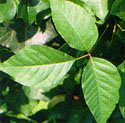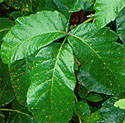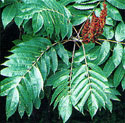 |
 |
 |
|||||||||||||||||||||
 |
Poison Ivy By far the most common of these plants in this area of southern Mississippi is poison ivy. The volatile oils this plant produces give some people skin irritations – ranging from redness to severe blistering. This plant can be upright, climbing or trailing with adventitious roots. The three leaflets are alternate and are ovate to elliptic in shape. The margins (edges) of the leaves can be toothed or lobed and, VERY rarely, smooth. |
|||||||||||||||
 |
Poison Oak Poison oak is an erect shrub, usually about 3-6 feet tall, bushy, with alternate leaves of three leaflets, the leaflets generally lobed slightly or as much as an oak leaf. The central leaf is stalked. The leaves are generally bright green above, paler below. Fruits are small whitish berries. Not as common around this area as poison ivy, but very common on the west coast, especially low places, thickets and wooded slopes. In addition to the shrub form, poison oak may be found growing as a vine (very like wild grape, but with smooth bark) up to six inches in diameter. |
|||||||||||||||
 |
Poison Sumac Poison sumac occurs as a shrub, to perhaps 15-20 feet tall, often branched at the base. The leaves of poison sumac are Alternate with 7-13 leaflets, lateral leaflets without a petiole (leaflet stalk), terminal leaflet with a stalk. The midrib of the Leaf without a pair of wings of tissue that run between leaflet pairs. Fruits are small whitish berries in a long cluster. Found usually in wetlands, Maine to Minnesota, south to Texas and Florida. |
|||||||||||||||
|
|
||||||||||||||||